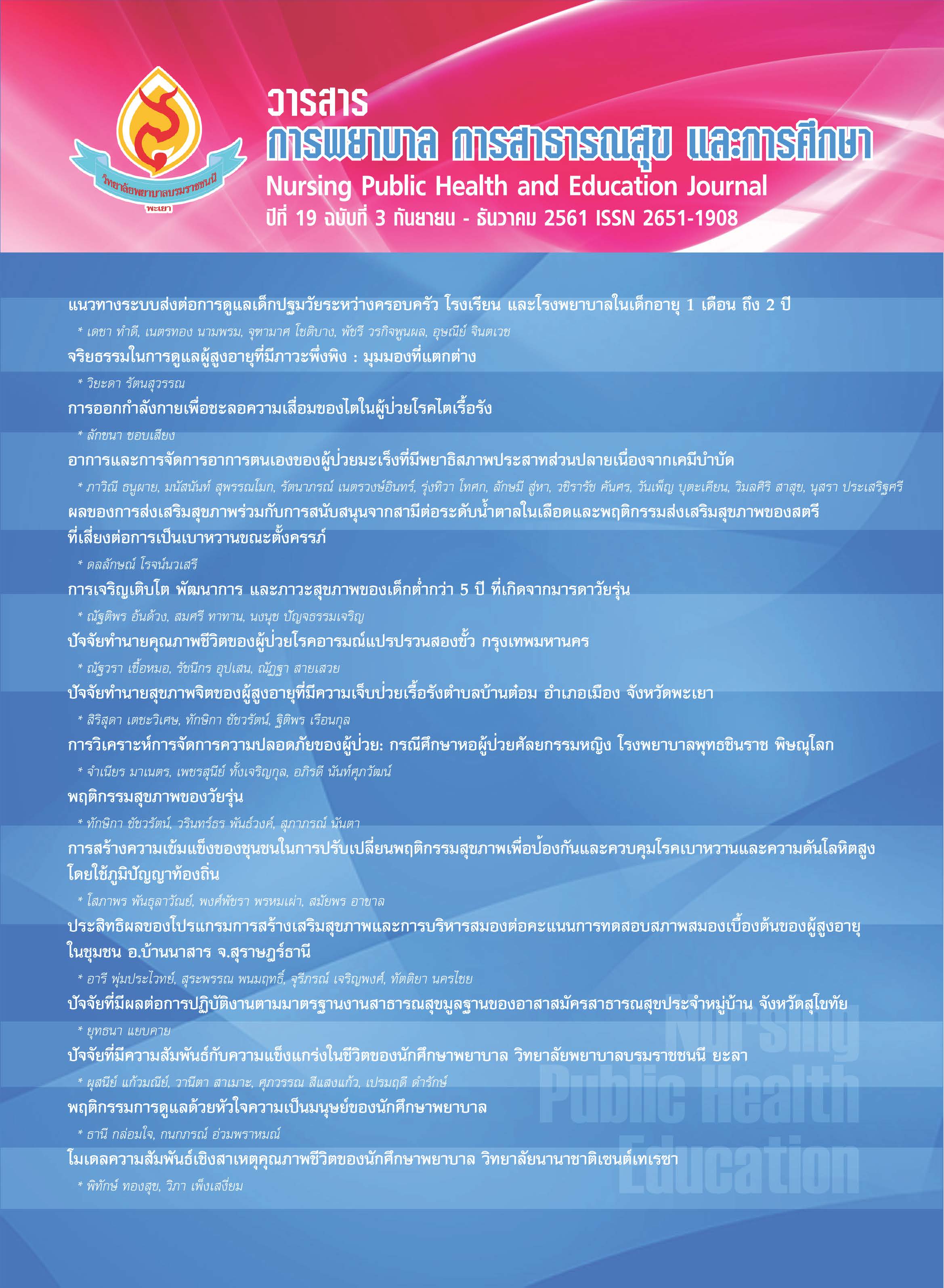ปัจจัยทำนายคุณภาพชีวิตของผู้ป่วยโรคอารมณ์แปรแปรปรวนสองขั้ว
Keywords:
ผู้ป่วยโรคอารมณ์แปรปรวนสองขั้ว, คุณภาพชีวิต, Patients with bipolar disorder, Quality of lifeAbstract
การศึกษาครั้งนี้เป็นการวิจัยเชิงบรรยาย มีวัตถุประสงค์เพื่อศึกษาคุณภาพชีวิตของผู้ป่วยโรคอารมณ์แปรปรวนสองขั้ว และศึกษาปัจจัยทำนายคุณภาพชีวิตของผู้ป่วยโรคอารมณ์แปรปรวนสองขั้ว ตัวแปรที่ศึกษาได้แก่ อายุ ระดับการศึกษา ประวัติการใช้สารเสพติดอาการข้างเคียงจากการใช้ยา อาการซึมเศร้า อาการแมเนีย การสนับสนุนทางสังคม และการจัดการกับอาการด้วยตนเอง กลุ่มตัวอย่างคือ ผู้ป่วยโรคอารมณ์แปรปรวนสองขั้วที่มารับการรักษาในแผนกผู้ป่วยนอกที่คณะแพทยศาสตร์ศิริราชพยาบาล มหาวิทยาลัยมหิดล คณะแพทยศาสตร์โรงพยาบาลรามาธิบดี มหาวิทยาลัยมหิดล โรงพยาบาลพระมงกุฎเกล้า และคณะแพทยศาสตร์วชิรพยาบาล มหาวิทยาลัยนวมินทราธิราช จำนวน 168 คน เลือกกลุ่มตัวอย่างที่มีคุณสมบัติตามเกณฑ์ที่กำหนดไว้ เครื่องมือที่ใช้ในการเก็บรวบรวมข้อมูลประกอบด้วยเครื่องมือ 7 ส่วน เครื่องมือทุกส่วนได้รับการตรวจสอบความตรงเชิงเนื้อหา โดยผู้ทรงคุณวุฒิ 5 ท่านโดยมีค่าความเที่ยงสัมประสิทธิ์แอลฟาครอนบาคของเครื่องมือทุกชุด เท่ากับ .82, .81, .82, .94, .81 และ .84 ตามลำดับ วิเคราะห์ข้อมูลโดยหาค่าเฉลี่ย ส่วนเบี่ยงเบนมาตรฐาน และวิเคราะห์การถดถอยพหุ แบบเข้าทีละตัว ผลการวิจัย สรุปได้ดังนี้
- ผู้ป่วยโรคอารมณ์แปรปรวนสองขั้วมีคุณภาพชีวิตโดยรวมอยู่ในระดับปานกลาง (x̄ = 84.61) และมีคุณภาพชีวิตรายด้านทุกองค์ประกอบย่อยในระดับปานกลาง ได้แก่ ด้านสิ่งแวดล้อม (x̄ = 26.50) ด้านร่างกาย (x̄ = 22.96) ด้านจิตใจ (x̄ = 19.72) และด้านความสัมพันธ์ทางสังคม (x̄ = 9.06)
- ตัวแปรที่สามารถร่วมกันทำนายคุณภาพชีวิตของผู้ป่วยโรคอารมณ์แปรปรวนสองขั้วได้อย่างมีนัยสำคัญทางสถิติที่ระดับ .05 คือ การสนับสนุนทางสังคม อายุ อาการซึมเศร้า และระดับการศึกษา โดยมีค่าความแปรปรวนของการพยากรณ์ร้อยละ 42.9 (R2 = 0.429)
PREDICTING FACTORS OF QUALITY OF LIFE IN PATIENTS WITH BIPOLAR DISORDER
The purposes of this descriptive research were to study the quality of life in patient with bipolar disorders and to determine the predictors on quality of life in bipolar patients. The predicting variables were factors related to age, education, substance abuse, side effects of antipsychotic drug, depressive symptoms, manic symptoms, social support and symptom self-management. Research sample were 168 bipolar patients with receiving mental health treatments in outpatient department from Faculty of Medicine Siriraj Hospital Mahidol University, Faculty of Medicine Ramathibodi Hospital Mahidol University, Phramongkutklao Hospital and Faculty of Medicine Vajira Hospital Navamindradhiraj University selected by inclusion and exclusion criteria. Research instruments divided into 7 parts which were tested for validity by 5 experts. The reliability of the scales with and Chronbach’s alpha were .82, .81, .82, .94, .81 and .84 respectively. Data were analyzed using mean, SD, and Enter multiple regression. Major findings were as follows :
- Bipolar patients had score on overall quality of life in the moderate level (x̄ = 84.61).
In addition all subscale of quality of life including environment domain, physical domain, psychological domail and social relation domain (x̄ = 26.50, x̄ = 22.96, x̄ = 19.72, x̄ = 9.06, respectively).
- Factors significantly predicted quality of life bipolar patients were social support, Age, depression and education, at the level of .05. These predictors were accounted for 42.9 percent ( R2 =.429 )
References
จินตนา ยูนิพันธ์. (2542). การพยาบาลชีวิตที่เป็นสุข.วารสารการพยาบาลจิตเวชและสุขภาพจิต,13, 1-13.
ณัฐกร จำปาทอง. (2554). mhGAP Intervention Guide สำหรับโรคทางสุขภาพจิตและจิตเวช โรคทาง ระบบประสาท และโรคที่เกิดจากการใช้สารเสพติดในหน่วยบริการสาธารณสุขที่ไม่ใช่หน่วย เฉพาะทาง. (ฉบับที่ 1). กรุงเทพมหานคร: กรมสุขภาพจิต กระทรวงสาธารณสุข.
ธวัชชัย ลีฬหานาจ, สุวรรณา เรืองกาณจนเศรษฐ์, รณชัย คงสกนธ์. (2545). ลิเทียมเปรียบเทียบกับลิเที่ยม
ร่วมกับ Cabamazepine ในการรักษา bipolar disorder : การวิเคราะห์ต้นทุนและประสิทธิผล. วารสารสมาคมจิตแพทย์แห่งประเทศไทย, 47, 97-110.
นันทนา สุขสมนิรันดร, เพ็ญพักตร์ อุทิศ. (2552). ปัจจัยคัดสรรที่สัมพันธ์กับคุณภาพชีวิตของผู้ป่วยโรค
อารมณ์แปรปรวนสองขั้ว. วิทยานิพนธ์, กรุงเทพมหานคร: จุฬาลงกรณ์มหาวิทยาลัย.
พิเชฐ อุดมรัตน์. (2547). การทบทวนองค์ความรู้และงานวิจัยที่เกี่ยวข้องในเรื่องระบาดวิทยาของปัญหา
สุขภาพจิตและโรคทางจิตเวช. กรุงเทพมหานคร: สำนักงานกิจการโรงพิมพ์ องค์การสงเคราะห์ ทหารผ่านศึก.
รณชัย คงสกนธ์, สมบัติ ศาสตร์รุ่งภัค, อวยชัย โรจนนิรันกิจ, อุไร บูรณเชษฐ์. (2546). การพัฒนาแบบ ประเมิน Montgomery Asberg Depression Rating Scale (MADRS) ฉบับภาษาไทย. วารสาร
จิตแพทย์แห่งประเทศไทย, 48, 218-211.
รณชัย คงสกนธ์. (2549). เครื่องมือที่ใช้ประเมิน Bipolar Disorder. ใน: ธวัชชัย ลีฬหานาจ,
สรยุทธ์ วสิกนานนนท์. (บรรณาธิการ), ตำราไบโพลาร์. กรุงเทพมหานคร: สมาคมจิตแพทย์ แห่งประเทศไทย.
สุวัฒน์ มหัตนิรันดร์กุล, วิระวรรณ ตันติพิวัฒนสกุล, วนิดา พุ่มไพศาลชัย, กรองจิต วงศ์สุวรรณ,
ราณี พรมานะจิรังกุล. (2541). เปรียบเทียบแบบวัดคุณภาพชีวิตขององค์การอนามัยโลกชุด 100 ตัวชี้วัด และ 26 ตัวชี้วัด. เชียงใหม่: โรงพยาบาลสวนปรุง.
สรยุทธ วาสิกนานนท์. (2549). ระบาทวิทยาและภาระโรค. ในธวัชชัย ลีฬหานาจ, สรยุทธ์ วสิกนานนท์ (บรรณาธิการ), ตำราไบโพลาร์, กรุงเทพมหานคร: สมาคมจิตแพทย์แห่งประเทศไทย 2549 (หน้า 63-67).
Barrera, M, Sandler I. (1981). Preliminary development of a scale of social support: studies on college students. Am J Community Psychol, 9, pp. 435-447.
Kim Yoon-Seok., Cha Boseok., Lee Dongyun., Kim Sun-Mi., Moon Eunsoo,
Park Chul-Soo., et. at. (2013). The Relationship between Impulsivity and Quality of Life in Euthymic Patients with Bipolar Disorder. Korean neuropsychiatric Association, 10, 246-252.
Kim Yoon-Seok., Cha Boseok., Lee Dongyun., Kim Sun-Mi., Moon Eunsoo., Park Chul-Soo., et. at. (2013). The Relationship between Impulsivity and Quality of Life in Euthymic Patients with Bipolar Disorder. Korean neuropsychiatric Association, 10, pp. 246-252.
Michalak E.E., Yatham L., Lam R.W. (2008). Quality of life in bipolar disorder: A review of literature. 2008 April [cited 2008 April 25] .Available from: http//www.hqlo.com/content/3/1/72
Montgomery S, Asberg M. (1979). A new depression rating scale designed to be sensitive to change. Br J Psychiatry, 134, pp. 382-389.
Murphy M., Moller M. (1997). Relapse management in neurobiological disorders: The Moller- Murphy symptom management assessment tool. Archives of Psychiatric Nursing, 7, pp. 226- 235.
Orem,D.E. (1985). Nursing concepts of practice. (3 rd ed). New York Macgraw-Hill.
Pini, S., Queiraz V., Paynin D., Pezawas L., Angst J., Cassano C.B., et al. (2005). Prevalence and burden of bipolar disorder in the general population: European coantries: Eur Nueropsychopharmacol, 15(2), pp. 135-141.
Sarika K K, Baby Shari PA. Quality of life and Depression among Bipolar Disorder. (2015). International Journal of Information & Futuristic Research, 2, pp. 2692-2697.
Schaefer C., Colyne C., Lazarus R.S. (1981). The health relate function of social support. Journal of behavior medicine. 4, pp. 381-406.
Singh J., Mattoo S.K., Sharan P., Basu D. (2005). Quality of life and its correlations in patients with dual diagnosis of bipolar affective disorder and substance dependence. Bipolar Disorder. 7, pp. 187-191.
Stuart G.W., Laraia M.T. (2005). Principles and Practice of Psychiatric Nursing. Missouri: Mosby.
Suppes, T. and Dennehy, E. B. (2005). Bipolar disorder: The latest assessment and treatment strategies. Missouri: Compct clinicals.
Thorndike R M. (1978). Correlational procedures for research. New York: Garner Press.
Vornik L.A., Hirschfeld R.M. (2005). Bipolar Disorder: Quality of life and the impact of Atypical
Antipsychotics. The American Journal of Manage Care,11(9).
Wang Y.H. Study on life quality and its associated factors of rheumatoid arthritis patients. (1999).
J Chang Gung Institute Technol, 2, pp. 108-120.
Wood S.W. (2006). The economic burden of bipolar disorder. J Clin Psychiatry 61 (Supp 13).
2000, 61, pp. 38-41.
Yen Cheng-Fang., Cheng Chung-Ping., Huang Chi-Fen., Yen Ju-Yu., Ko Chih-Hung.,
Chen Cheng-Sheng. (2008). Quality of life and its association with insight, adverse effects of medication and use of atypical antipsychotics in patients with bipolar disorder and schizophrenia in remission. Bipolar Disorder, 10, pp. 617-624.
Young R.C., Briggs J.T., Ziegler B.E., Mayer D.A. (1978). A rating scale for mania: reliability, validity and sensitivity. Br J Psychiatry, 133, pp. 429-435.
Zhang H., Wisniewski S.R., Bauer M.S, Sachs G.S., Thase M.E. (2006). Comparisons of perceived
quality of life across clinical states in bipolar disorder data from the first 2000 Systematic Treatment Enhancement Program for Bipolar Disorder (STEP- BD) participants. Comprehensive Psychiatry. 47, pp.161-168.


